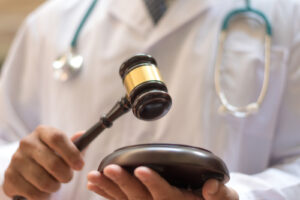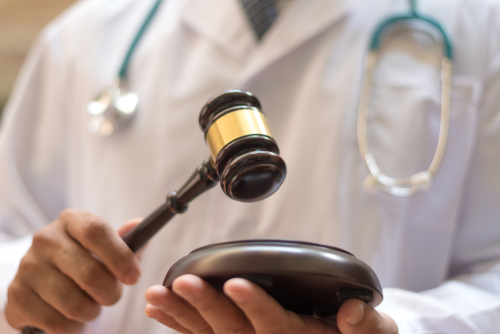By Madison Neale
During the process of prosecuting a case of child abuse, the testimony of a medical professional hired as an expert witness for the state is often pivotal.[1] This can pose a number of difficulties for defendants, because juries tend to find expert witnesses highly persuasive.[2] The very term “expert” holds a lot of weight, and juries tend to accept what an expert testifies to at face value.[3] This is especially true when said expert witness is a doctor.[4] But medicine, like all sciences, is ever changing, improving, and correcting itself.
The testimony of these experts is typically used to show that a child’s injuries most likely resulted from abuse rather than a pre-existing illness or accidental injury.[5] The expert may be asked to state their conclusion with “reasonable medical certainty.” [6] This is a concept that hasn’t been particularly well flushed out by the courts, but may signal to a juror they are hearing highly reliable testimony.[7] One type of case, which almost always involves the use of a medical expert witness, are those regarding “Shaken Baby Syndrome” (SBS).[8] SBS is typically diagnosed based on a “triad” of diagnostic injuries—“cerebral edema (brain swelling), subdural hematomas ([bleeding in the brain]), and retinal hemorrhages (bleeding inside the surface of the back of the eye).”[9] The theory posited by doctors is that these injuries only occur simultaneously when an infant has been vigorously shaken forward and backward.[10] The implication behind such an assertion is that a parent or caregiver became so frustrated with a crying baby, that they shook them to the point of serious injury or death.[11]
Clearly, such an assertion, if true, is tragic and would result in serious penalties to the child’s abuser. The theory of Shaken Baby Syndrome was first proffered by pediatric neurosurgeon, Norman Guthkelch, in 1971.[12] The first SBS case was prosecuted in 1984, and by the late 1990s, the “triad” of symptoms described above was essentially accepted as a dispositive diagnosis of SBS.”[13] Today, however, doubt is being cast on the idea that we can absolutely rule out any other cause of these symptoms.
Skeptics have pointed to the fact that SBS is a highly under-researched area of medicine.[14] Yet, when medical experts take the stand, they tend to make a declaration of SBS with apparent certainty.[15] Acta Paediatrica, a peer-reviewed medical journal covering pediatrics, conducted a literature search of publications dealing with SBS and assessed them for bias.[16] An initial search of 3,773 abstracts was narrowed down to 30 studies, which were ultimately included for assessment.[17] “Of these [30 studies], 28 were assessed as having a high risk of bias, which was associated with methodological shortcomings as well as circular reasoning when classifying shaken baby cases and controls.”[18]
The Swedish Agency for Health Tech. Assessment & Assessment of Social Services conducted a study of other factors which could lead to one or more of the “triad” symptoms (and its components), identifying 35 different medical events which could produce such symptoms.[19]
Despite ever-growing concern among medical and legal experts, SBS cases are still being pursued. In 2020, the Supreme Court of Virginia affirmed Andrew Stephens’s conviction of “maliciously wounding” his daughter on the theory of SBS.[20] The case rested almost entirely on the testimony of Dr. Susan Lamb, the state’s expert witness, who testified that “there can be causes of abusive head trauma other than child abuse, although they are rare”.[21] The Stephens family hired their own expert witness who contradicted Dr. Lamb’s testimony, but to no avail.[22]
At the very least, there is ample evidence that Shaken Baby Syndrome needs to be more thoroughly studied, should these cases continue to be prosecuted. Because SBS cases are unique in the fact that they tend to rely almost exclusively on expert testimony, prosecutors have a duty to concern themselves with the reliability of that testimony. Child abuse is a wholly intolerable crime which courts and prosecutors should review with special care and some of the highest levels of scrutiny. But to separate an innocent parent or caregiver from their family is another kind of injustice, one the state should be concerned with preventing.
[1] David L. Chadwick & Henry F. Krous, Irresponsible Testimony by Medical Experts in Cases Involving the Physical Abuse and Neglect of Children, 2 Child Maltreatment 313, 313 (1997).
[2] Kristy A. Martire et al., Exploring juror evaluations of expert opinions using the Expert Persuasion Expectancy framework, 25 Legal and Criminological Psychology. 90, 97 (2020) (“On average, the control strong expert opinion was rated 88.4 out of 100 (SD = 2.73) for persuasiveness indicating that participants found it highly convincing.”).
[3] Id.
[4] Id.
[5] Mark S. Dias et al., Defining ‘reasonable medical certainty’ in court: What does it mean to medical experts in child abuse cases?, 50 Child Abuse & Neglect 218, 218 (2015).
[6] Id.
[7] Id.
[8] Deborah Tuerkheimer, Science-Dependent Prosecution and the Problem of Epistemic Contingency: A Study of Shaken Baby Syndrome, 62 Ala. L. Rev. 513, 513 (2011).
[9] Id.
[10] Id.
[11] Id.
[12] Niels Lynøe et al., Insufficient evidence for ‘shaken baby syndrome’–a systematic review, 107 Acta Paediatrica 1021, 1021 (2017).
[13] Deborah W. Denno, Concocting Criminal Intent, 105 Geo. L.J. 323, 341-43 (2017).
[14] Lynøe et al., supra note 13, at 1026.
[15] Chadwick & Krous, supra note 1, at 315.
[16] Lynøe et al., supra note 13, at 1023.
[17] Id.
[18] Id.
[19] Göran Elinder et al., Traumatic Shaking: The Role of the Triad in Medical Investigations of Suspected Traumatic Shaking—A Systemic Review, 107 Acta Paediatrica 3, 19 (2018).
[20] Stephens v. Clarke, No. 190510, 2020 WL 2096110, at *4 (Va. Apr. 30, 2020).
[21] Id. at 4.
[22] Id. at 5.
